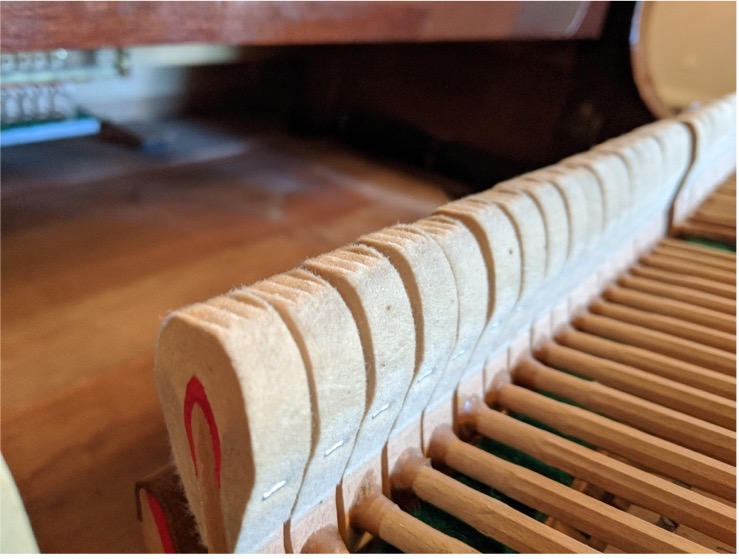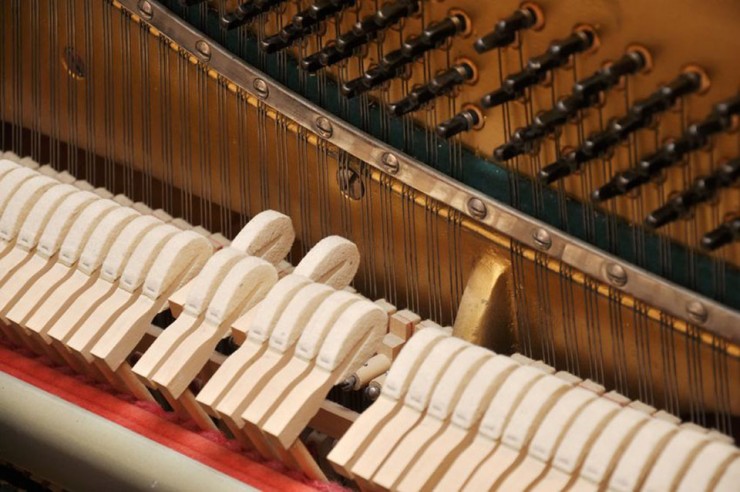Piano hammers typically last 10 to 20 years, depending on usage and conditions. Regular maintenance can extend their lifespan.
A grand piano or upright piano is a significant investment for any musician, and ensuring its longevity is crucial. Central to a piano’s sound quality are its hammers, which strike the strings to produce music. The lifespan of these hammers can vary greatly.
Frequent players or those with heavy touch may find they need replacements sooner, while those with lighter use could see their hammers last beyond 20 years. Factors such as humidity, temperature, and the quality of the hammer felt also play a role in durability. To preserve your piano’s pristine sound, consider routine inspections and adjustments by a professional. Regular care not only extends the life of the hammers but also keeps your piano in top playing condition, ensuring beautiful music for years to come.
The Life Of Piano Hammers
Piano hammers play a critical role in the sound of a piano. These felt-covered pieces of wood strike the strings and create the instrument’s tone. Lifespan varies based on various factors.
Factors Affecting Durability
Different aspects influence piano hammer durability. Among these are:
- Quality of Material: Higher quality felt and wood last longer.
- Frequency of Use: Pianos played often wear out quicker.
- Playing Style: Heavy-handed playing accelerates wear.
- Environment: Humidity and temperature affect hammer life.
- Maintenance: Regular tuning and care extend lifespan.
Signs Of Wear And Tear
Look out for these indicators that piano hammers may need attention:
- Flattened Felt: Indicative of significant use.
- Uneven Tones: Some notes may sound different than others.
- String Impressions: Marks on the hammers from strings.
- Compromised Resilience: Hammers bounce back poorly after striking.

Credit: kawai.com.au
Regular Maintenance Impact
Regular maintenance remarkably extends the life of your piano hammers. These essential parts dictate the quality and character of your piano’s sound. Neglecting their care leads to premature wear, muffled tones, and a compromised playing experience. Caring for your piano hammers goes beyond the occasional dusting; it includes routine tuning and voicing that enhance longevity and performance.
Tuning Influence On Hammer Life
Tuning does more than just keep your piano sounding pitch-perfect. It influences how hammers strike strings, affecting their wear rate. A well-tuned piano ensures even striking, reducing unnecessary stress on the felt of the hammers.
- Regular tuning prevents the hardening of hammer felt.
- Tuning maintains even tension across strings, promoting uniform hammer wear.
- Consistent sound quality and playability result from routine tuning.
Benefits Of Periodic Voicing
Voicing adjusts a piano’s tone or quality of sound that hammers produce. Periodic voicing has distinct benefits:
| Voicing Benefit | Impact on Hammer |
|---|---|
| Restores dynamic range | Prevents flattening of the hammer |
| Reshapes worn hammers | Extends the hammer’s useful life |
| Adjusts tone brightness | Reduces harshness, allowing softer playing |
A good voicing regimen ensures that the hammers maintain their shape and elasticity. This translates to a reduced need to replace them frequently, saving time and money.
- Enhances overall sound quality and expressiveness.
- Keeps the piano sounding rich and balanced.
- Improves player satisfaction and audience enjoyment.
Material And Craftsmanship
The heart of a piano’s sound lies in its hammers. The lifespan of piano hammers depends on two key factors: material and craftsmanship. High-quality materials combined with expert craftsmanship ensure that hammers can withstand thousands of strikes against the piano strings. Let’s dive into the details that determine the durability and tone of piano hammers.
Types Of Felt And Wood
Piano hammers are made from felt and wood, each contributing to the instrument’s sound and touch. Felt, usually made from wool, covers the wooden core of the hammer. Different types of felt and wood, affect tone and durability.
- Virgin Wool Felt: Dense and resilient, it produces a clear, rich tone.
- Merino Wool Felt: Offers a soft, warm sound preferred by some pianists.
- Hardwood: Such as maple, gives hammers strength and longevity.
- Softwood: Like mahogany, is lighter, affecting the hammer’s action.
Quality And Longevity Correlation
The relationship between quality and longevity in piano hammers is direct. Premium materials and precision in crafting contribute to both a superior sound and an extended life for the hammers.
| Quality Aspect | Impact on Longevity |
|---|---|
| Dense Felt | Less wear over time |
| Fine Wood Grain | Better resilience to strikes |
| Expert Shaping | Even tone and durability |
| Proper Voicing | Maintains sound quality for years |
A well-crafted piano hammer can last for decades, while inferior ones may need replacement much sooner. By choosing a piano with top-notch hammers, you ensure a beautiful sound for years to come. Remember, the longevity of your piano’s hammers is a testament to the materials and craftsmanship invested in them.

Credit: www.thepiano.sg
Usage Intensity And Hammer Longevity
Understanding how usage intensity impacts hammer longevity is key in predicting the life span of a piano’s hammers. Pianos are treasured instruments that bring melody to life, yet their components, like hammers, undergo wear and tear. The longevity of piano hammers isn’t solely a matter of years – it’s deeply influenced by how often and how hard they’re played. Let’s dive into how playing frequency and the distinction between professional and casual use can affect your piano’s hammers.
Effect Of Playing Frequency
Frequent playing equates to more wear on piano hammers. Each key press triggers a hammer strike on the string, which over time contributes to felt compacting and grooves forming. The type of music played also makes a difference; lively tunes often lead to quicker degradation compared to softer pieces.
- Daily players may see hammers wear faster.
- Occasional use leads to extended hammer life.
- Genre matters – classical may wear down hammers less than jazz or pop.
Let’s quantify the effect with an estimate:
| Playing Frequency | Est. Hammer Longevity |
|---|---|
| Daily (Professional) | 1-3 years |
| Weekly (Casual/Avid) | 3-5 years |
| Monthly (Casual) | 5+ years |
Professional Vs. Casual Use
Professional pianists demand excellence from their instruments. Their hammers face rigorous workouts, leading to frequent replacements to maintain peak performance. In contrast, casual pianists often find their hammers lasting much longer due to the lighter and less frequent use.
- Professionals: high-intensity use challenges hammer durability.
- Casuals: Less strain on hammers extends their lifespan.
The difference is clear:
| User Type | Intensity | Replacement Frequency |
|---|---|---|
| Professional | High | Often |
| Casual | Low | Less Often |
Maintaining a piano and understanding its mechanics ensures the instrument sings beautifully for years to come. Recognize your playing habits to anticipate the needs of your piano hammers, and seek professional advice for personalized care.
Replacing Piano Hammers
Replacing piano hammers is a critical step in maintaining the rich, resonant sound pianos are known for. Constant striking against strings during play eventually wears down the hammers, affecting the piano’s tone and touch. Knowing when to replace them and understanding the process, including the costs involved, is essential for any piano owner aiming to keep their instrument in prime condition.
When To Consider Replacement
Several signs indicate it may be time to replace your piano hammers:
- Flattened hammer felt can’t produce the right tone.
- Deep grooves in the felt affect sound clarity.
- Hardened felt results in overly bright, harsh tones.
- Inconsistent tonal quality suggests uneven wear.
Professional assessment confirms replacement necessity.
Cost And Process Of Hammer Renewal
Replacing piano hammers involves both material and labor costs:
| Aspect | Details |
|---|---|
| Materials | Quality hammers, shanks, and related components. |
| Labor | Dismantling, fitting, and voicing by a technician. |
| Cost Range | Varies by piano type and technician rates. |
The renewal process includes:
- Selecting the right hammers for your piano.
- Removing worn hammers and installing new ones.
- Voicing hammers to ensure a balanced sound.
- Fine-tuning the instrument post-installation.
Choose a reputable technician for the best outcome.
Extending Hammer Life
The lifespan of piano hammers is vital for the instrument’s performance. You can take steps to extend this lifespan. Let’s explore some key practices under “Extending Hammer Life”.
Protective Measures
Proper care maintains piano hammer quality. Here are some protective measures to consider:
- Controlled Humidity: Keep your piano in a room with stable humidity. This prevents hammer felt from hardening or softening.
- Avoid Direct Sunlight: Sun can damage hammers. Position your piano away from windows where sunlight pours in.
- Dust Cover: Use a dust cover when the piano is not in use. Dust can wear down the felt on the hammers.
- Gentle Play: Playing gently can reduce hammer wear. Avoid striking the keys too hard.
Professional Interventions
At times, hammers need professional care. Find out what professional interventions can do:
| Service | Benefits |
|---|---|
| Regular Tuning: | Keeps the action aligned and prevents uneven hammer wear. |
| Voice Adjustments: | Helps maintain the hammer’s shape and dynamic range. |
| Hammer Resurfacing: | Removes compacted felt and restores the hammers’ original quality. |
| Replacement: | Substitutes worn hammers to restore sound quality. |
Investing in these professional interventions can significantly prolong the hammers’ life in your piano.

Credit: www.pianomagic.com.au
Do Different Piano Brands Have Different Durabilities for Their Hammers?
When it comes to the durability of hammers, the best piano keyboard brand is often known for using high-quality materials that can withstand frequent use. Different piano brands may vary in the durability of their hammers, with some prioritizing longevity and others focusing on other aspects of the instrument.
Frequently Asked Questions For How Long Do Piano Hammers Last
When Should I Replace My Piano Hammers?
Replace your piano hammers when they show significant wear, produce uneven or dull tones, or after intensive use over many years. Regular assessments by a technician can help determine the right time for replacement.
How Long Do Hammers Last?
Hammers typically last for years with proper care, but heavy use can shorten their lifespan. Regular maintenance extends their durability.
How Much Does It Cost To Replace Piano Hammers?
Replacing piano hammers typically costs between $1,000 to $3,000, varying by piano type and technician fees.
What Is The Life Expectancy Of A Piano?
The average life expectancy of a piano is around 40 to 60 years. Regular maintenance can extend its life beyond 100 years.
Conclusion
Piano hammers withstand thousands of strikes, but they do wear out. Their longevity hinges on material quality, playing frequency, and maintenance diligence. Proper care can extend their life, ensuring years of melodious play. Regular check-ups by professionals are advised. Ultimately, your piano’s voice rests on the hammers’ condition.
Keep them in tune for a timeless sound.
{ “@context”: “https://schema.org”, “@type”: “FAQPage”, “mainEntity”: [ { “@type”: “Question”, “name”: “When should I replace my piano hammers?”, “acceptedAnswer”: { “@type”: “Answer”, “text”: “Replace your piano hammers when they show significant wear, produce uneven or dull tones, or after intensive use over many years. Regular assessments by a technician can help determine the right time for replacement.” } } , { “@type”: “Question”, “name”: “How long do hammers last?”, “acceptedAnswer”: { “@type”: “Answer”, “text”: “Hammers typically last for years with proper care, but heavy use can shorten their lifespan. Regular maintenance extends their durability.” } } , { “@type”: “Question”, “name”: “How much does it cost to replace piano hammers?”, “acceptedAnswer”: { “@type”: “Answer”, “text”: “Replacing piano hammers typically costs between $1,000 to $3,000, varying by piano type and technician fees.” } } , { “@type”: “Question”, “name”: “What is the life expectancy of a piano?”, “acceptedAnswer”: { “@type”: “Answer”, “text”: “The average life expectancy of a piano is around 40 to 60 years. Regular maintenance can extend its life beyond 100 years.” } } ] }